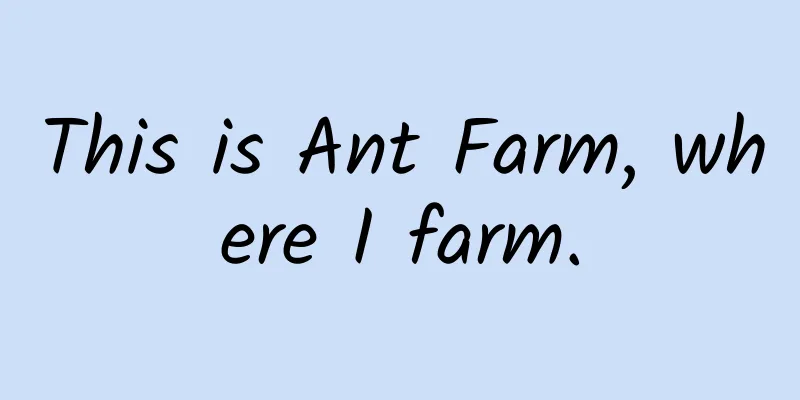This is Ant Farm, where I farm.

|
Author: Ge Yingqiang The article comes from the Science Academy official account (ID: kexuedayuan) —— Warm reminder: This article involves pictures of real insects. If you observe carefully, you may find their cuteness. However, readers who are really afraid of insects should be careful. It is early spring in March, the Waking of Insects has passed, the sound of spring thunder awakens the dormant animals, and the spring ploughing season has arrived. Humans have been engaged in agricultural farming for about 12,000 years. Compared with gathering and hunting, planting crops is a more stable way to obtain food sources. However, as early as 50 to 60 million years ago, insects had already mastered the skills of farming. Among the several types of insects that can "farm", such as ants, termites and beetles, leaf-cutter ants are the best. They achieve self-sufficiency in food resources by cultivating edible fungi. Today, I will tell you about the "ant farm" of leaf-cutter ants. A fruitful leafcutter ant farm (Photo credit: alexanderwild.com) We worker ants have power As the name suggests, the most well-known behavior of leaf-cutter ants is that they use their well-developed mandibles to cut leaves. They do not eat the cut leaves directly, but bring them back to the ant nest as nutrients for cultivating fungi, so as to run their own "ant farm". Obtaining suitable plant leaves and growing fungi is not an easy task. Leaf-cutter ants need worker ants of different trades to cooperate with each other to complete this huge project. Busy leaf-cutter ant workers (Image source: sciencenews.org) The same type of leaf-cutter ant, with different roles and different body shapes (Image source: wikimedia.org) The first to be sent out are the agile worker ants who act as scouts. Their task is to go everywhere to search for plants that can be used to cultivate fungi. After finding a suitable collection point, the scout will call for the large army of worker ants to come for support. The first wave of reinforcements are large worker ants that can use their mouths as scissors. The large worker ants use their extremely powerful mandibles to cut the entire leaf into multiple small pieces for easy transportation. If you want to do your work well, you must first sharpen your tools (Image source: fineartamerica.com) It's no wonder that large worker ants bite very round pieces (Image source: earthlife.net) After finding the plants and cutting off the leaves, the next thing to consider is the transportation problem. Although the large worker ants that cut the whole leaves have good teeth, their leg strength may be average, so the work of transporting leaf fragments is not done by them, but by smaller worker ants. In documentaries, we often see a huge army of leaf-cutter ants moving forward, with the cut leaf fragments on their heads. These guys are the small and medium-sized worker ants that act as transport soldiers. Transport soldier: "The distance you travel reveals the power of ants!" (Image source: wikimedia.org) After the transport soldiers return to the ant nest, they will hand over the leaf fragments to another role, the small worker ants. The small worker ants are responsible for the most complex and important subsequent processing in the process: they need to further process the leaf fragments, chew them continuously, and mix them with saliva to turn them into a paste-like nutrient substance, that is, to make the culture medium. In the process of making the culture medium, the small worker ants will also responsibly "add ingredients" - smear their own feces on the paste. This is because the feces contain a high nitrogen content, and the culture medium with added ingredients may be able to grow more fungi. After the culture medium is ready, the small worker ants will transplant the fungus species and then take good care of it until mature fungi that can be used grow. (I just don't know if the fungi grown in this way will have a smell...) "What you did before was physical work, but what I did is technical work!" (Image source: cdn.thinglink.me) Relying on the cooperation between different types of work, the leafcutter ant family has been able to feed itself by cultivating fungi for generations. In this process, the complex and sophisticated internal structure of the leafcutter ant nest also plays a significant role. There are many rooms inside the ant nest, like an underground palace, and the rooms are interconnected, which can be said to be crisscrossed. With a large number of rooms and openings, the ant nest can use the principle of thermal convection to exchange gases, continuously discharge carbon dioxide and take in fresh oxygen to ensure that the fungus cultivation room has an adequate oxygen supply. Moreover, the smart leafcutter ants will close the entrance to the ant nest under special circumstances such as rainy days and winter to prevent rainwater backflow or cold air invasion. A huge leaf-cutter ant nest (Photo source: bluebird-electric.net) Cultivating bacteria can also moisturize the surrounding areas The agricultural work of leafcutter ants has many benefits. In addition to providing food for family members and ensuring the prosperity of the population itself, it can also help improve the environment around the ant nest. By comparing the environment near and far from the leafcutter ant nest, the researchers found that the soil near the nest is more fertile and the adjacent plant communities have better growth parameters (i.e., higher plant radius, plant height, and rhizome biomass). Leafcutter ants are able to improve the surrounding soil and plants because a large amount of waste residues and waste from mushroom cultivation re-enters the food chain, promoting the circulation of nutrients. So how do leafcutter ants deal with their waste? Generally speaking, there are two methods: one is to have worker ants transport the waste fragments outside the nest (this method is called external dumping), which is beneficial to the growth of plants with shallow roots such as herbs and small trees; the other method is to accumulate the waste in a storage room deep inside the ant nest (this method is called internal dumping), which is beneficial to large trees with deep roots. Leaf-cutter ant workers busy carrying things at the entrance of the nest (Photo source: alexanderwild.com) Mushroom waste is also a treasure (Photo source: dirtyclassroom.com) Symbiotic fungi: You can’t eat me for free In the "Ant Farm", the relationship between leaf-cutter ants and fungi is not a simple edible relationship, but a mutually beneficial symbiotic relationship. In ecology, the most classic symbiotic relationship related to ants is "ant herding aphids": ants obtain aphids' honeydew as food while herding aphids, while aphids obtain ant bodyguards that can drive away natural enemies. The same is true of the symbiotic relationship between fungi and leaf-cutter ants - the leaf-cutter ants gain a steady source of food from the symbiotic fungi while also acting as bodyguards. However, the natural enemies that leaf-cutter ants have to drive away are some fungi that compete with symbiotic fungi. The small worker ants that can make culture media mentioned above have an additional task when taking care of symbiotic fungi, which is to pick out and move away the spores of other wild fungi. In addition, leaf-cutter ants themselves secrete some antibodies to inhibit the growth of harmful fungi (this is the weeding work of bipeds when they farm!). Being a farmer and a bodyguard is exhausting! (Image source: kqed.org) After a long period of co-evolution with leaf-cutter ants, the life history of fungi has also changed. Fungi generally reproduce and spread through fruiting bodies (i.e. mushrooms) and spores, but the symbiotic fungi cultivated by leaf-cutter ants are an exception. These symbiotic fungi no longer need to produce fruiting bodies and spores because leaf-cutter ants have become the only medium for their reproduction and spread. Leaf-cutter ants and symbiotic fungi "run in" with each other and depend on each other. Even young queen ants bring the fungal species from their original family when they split the nest and establish their own new family by cultivating a new ant farm. So, in the tens of millions of years of "ant farm" history, was it the leaf-cutter ants that domesticated the symbiotic fungi, or was it the symbiotic fungi that domesticated the leaf-cutter ants? References: [1] Farji-Brener, AG, Werenkraut. A meta-analysis of leaf-cutting ant nest effects on soil fertility and plant performance[J]. Ecological entomology, 2015,40(2):150-158. [2] Bollazzi M, Roces F. To build or not to build: circulating dry air organizes collective building for climate control in the leaf-cutting ant Acromyrmex ambiguus[J]. Animal Behavior, 2007, 74(Pt5):1349-1355. [3] Poulsen M, Hughes WOH, Boomsma JJ. Differential resistance and the importance of antibiotic production in Acromyrmex echinatior leaf-cutting ant castes towards the entomopathogenic fungus Aspergillus nomius[J]. Insectes Sociaux, 2006, 53(3):349-355. [4] Mueller UG, Gerardo N. Fungus-farming insects: Multiple origins and diverse evolutionary histories[J]. Proceedings of the National Academy of Sciences of the United States of America, 2002, 99(24):p.15247-15249. [5] www.smithsonianmag.com/science-nature/how-ants-became-worlds-best-fungus-farmers-180962871/ [6] www.sciencenews.org/article/insects-ants-extreme-farming-methods-offer-good-bad-lessons |
<<: Unveiling the Dragon: How Squids Evolved to Be Delicious | Paleontological Rhapsody
>>: Scientists, come on, protect our Xinjiang cotton!
Recommend
Cars have entered the era of intelligent connectivity. Honda, which offers "buy an engine and get a car for free", connects the future with technology
Technology has almost become a synonym for Honda,...
Fatal attraction! Why are we so obsessed with black holes?
When you stare into the abyss The abyss is also s...
With a 99.41% win rate that crushes human chess players, will AI really beat humans this time?
This time, AI beat humans again. A research team ...
If your child doesn't talk, does that mean he or she is "socially anxious"? Maybe you should learn about "selective mutism"
gossip Children who can talk happily and communic...
Follow the master "Du Yasong" to master the assessment and diagnosis of children and adolescents
Course Catalog 01 The significance of diagnosis a...
Xingning SEO Training: How important is Internet marketing to a business? Is SEO effective?
Nowadays, website optimization has long been indi...
Rolls-Royce's domestic sales in May 2024 fell 53.3% month-on-month, with only 57 units sold
Recently, the issue of domestic luxury brands sla...
How to promote and operate APP? You need to understand the fundamentals!
With the continuous development of the APP indust...
The conversion rate of information flow is only 10%, so where does the remaining 90% of traffic go?
The most painful thing in marketing promotion is:...
What are the blind spots in early APP operation and promotion?
After the app is launched, the next important tas...
Intelligent Question Answering: BERT-based Semantic Model
Author: Luo Zijian background Feishu Intelligent ...
Lock in the bull's IPOs in Hong Kong to make steady profits
Introduction to the practical course resources fo...
A complete guide to self-media monetization in 2020!
Please read this article carefully! Then you will...
3 interactive skills for novices to avoid dull moments in live streaming, essential tips for live streaming
Live streaming selling means chatting with custom...
Android-x86 4.4-r3 released, supports Baytrail platform
Android-x86 4.4-r3 was released. This is the thir...







![Yining SEO training: [Website domain name change steps] Preparation and follow-up work before changing the website domain name](/upload/images/67cc458d6ee7b.webp)

